Arizona is home to a diverse array of birds of prey, also known as raptors.
From the majestic bald eagle to the elusive owl, these birds are a sight to behold.
In this article, we will explore the 28 species of birds of prey that can be found in Arizona.
We will discuss their unique characteristics and habitats, and provide tips on how to spot them in the wild.
So come along as we take a closer look at Arizona’s feathered predators.
| Image | Name |
|---|---|
 | Red-tailed Hawk |
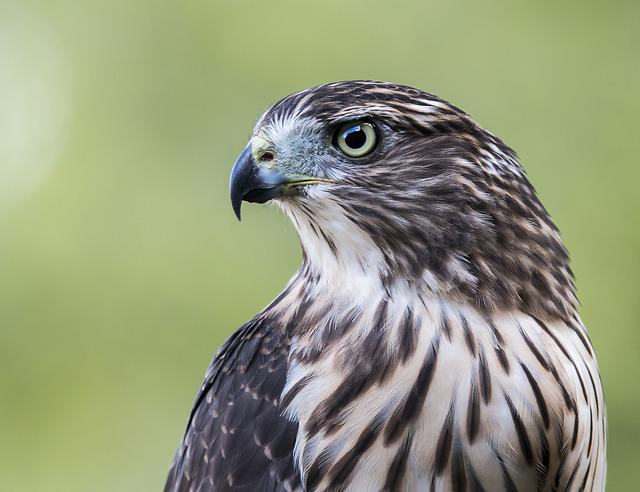 | Cooper's Hawk |
 | Sharp-Shinned Hawk |
 | Northern Goshawk |
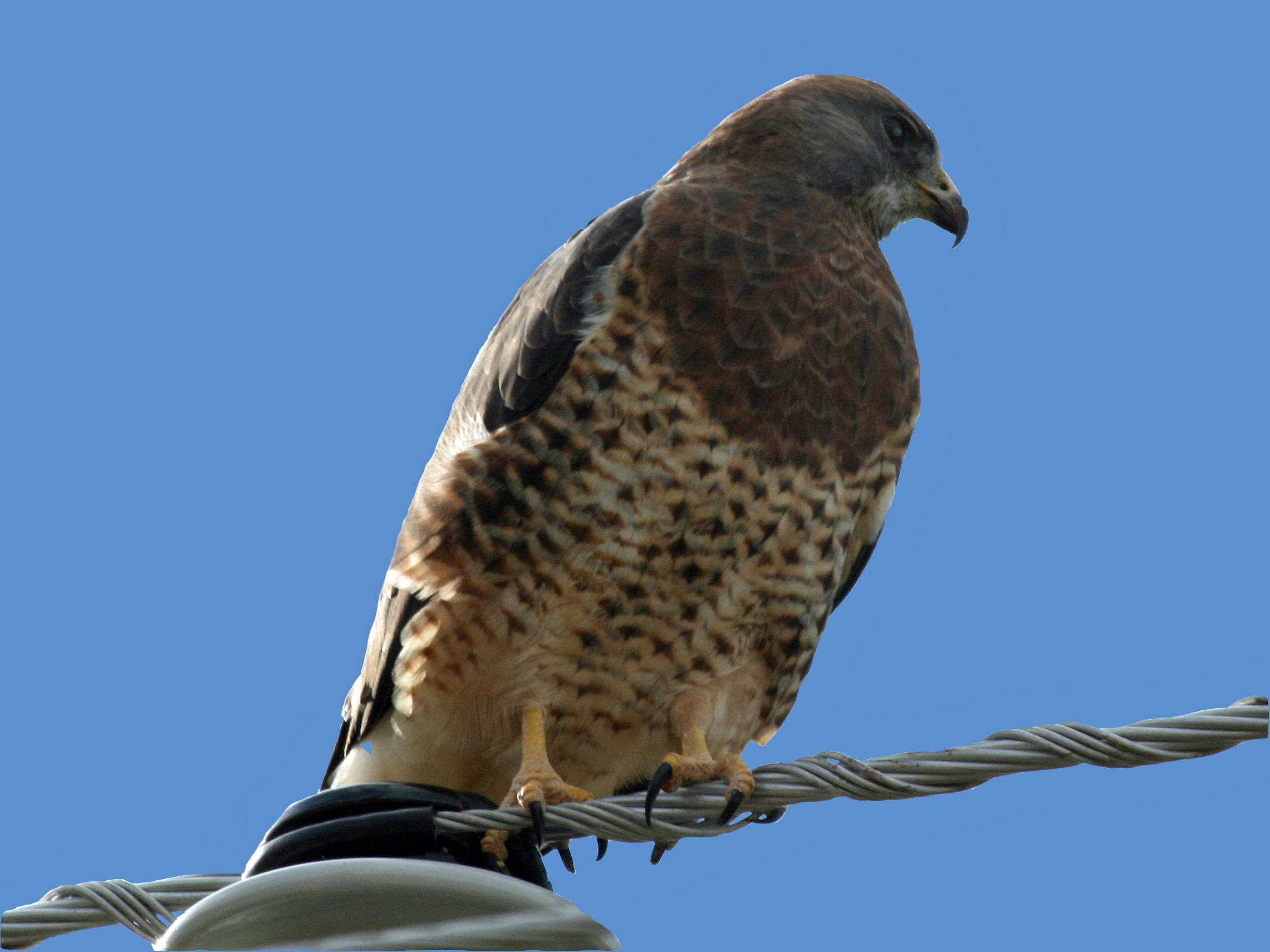 | Swainson's Hawk |
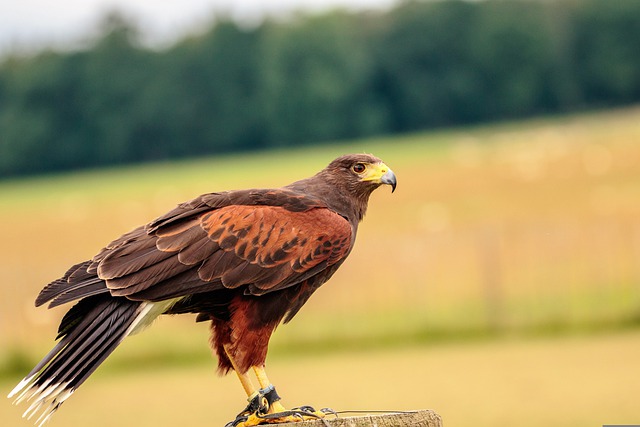 | Harris Hawk |
 | Rough-legged Hawk |
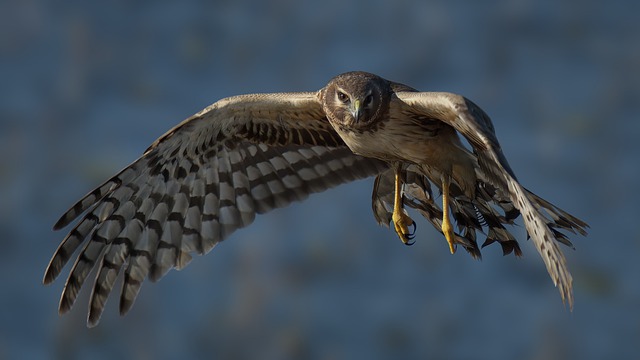 | Northern Harrier |
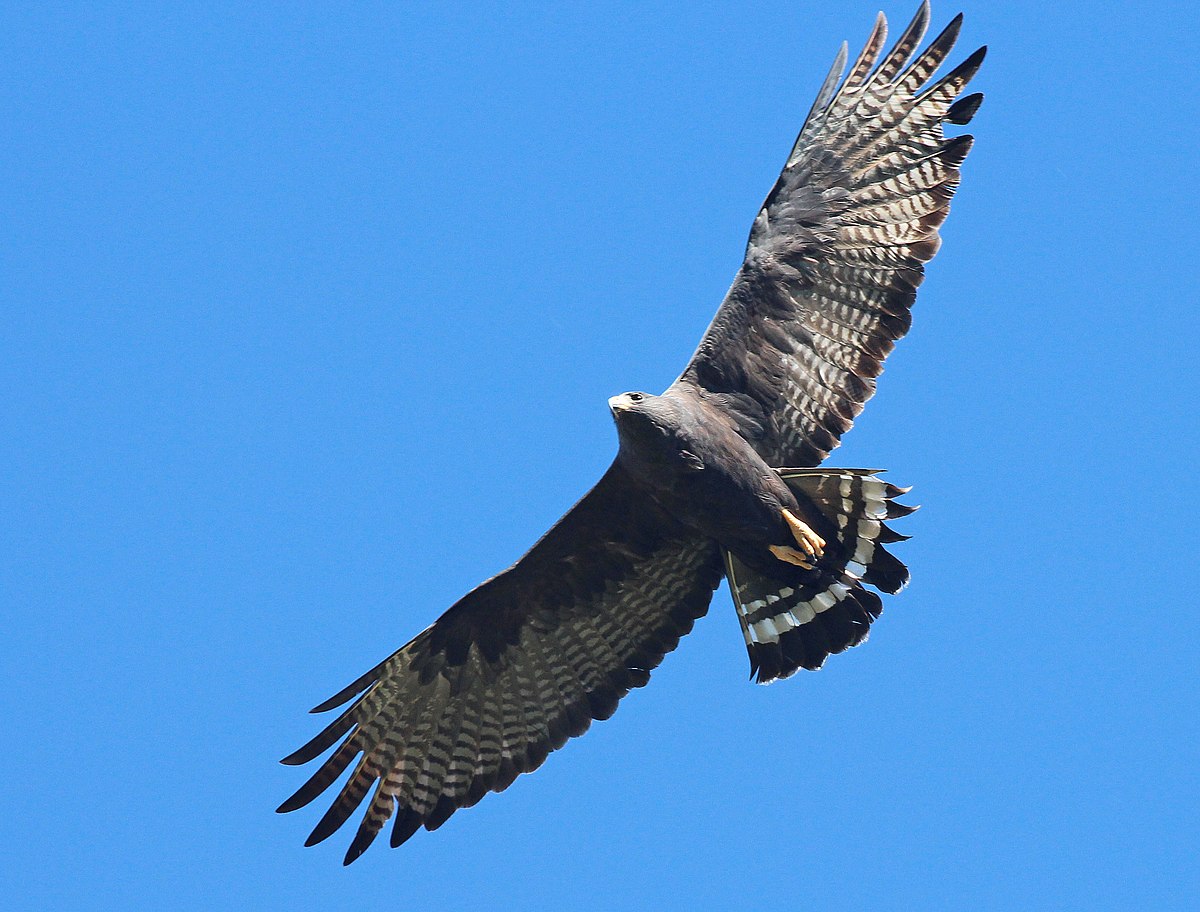 | Zone-tailed Hawk |
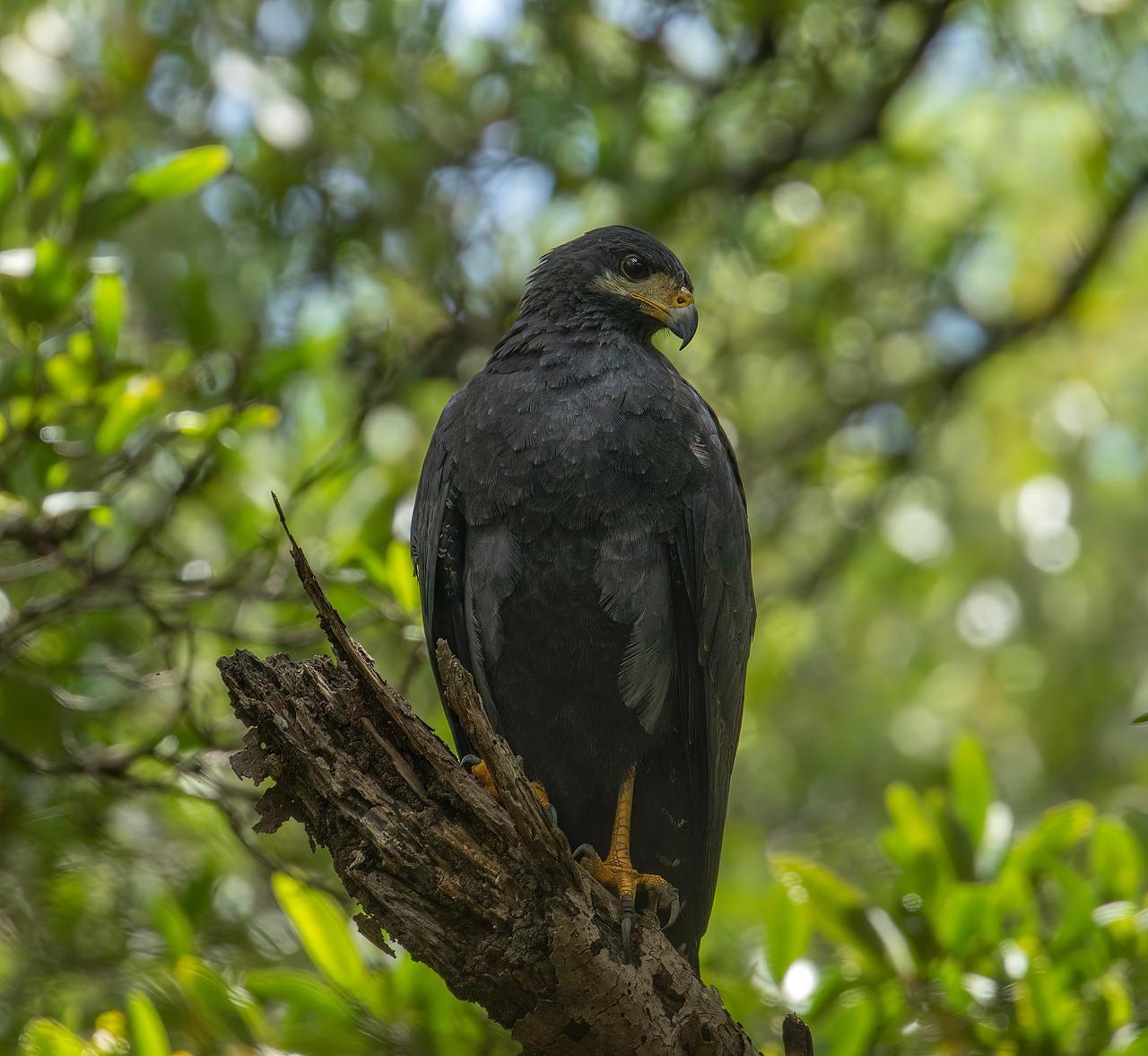 | Common Black Hawk |
 | Ferruginous Hawk |
 | Golden Eagle |
 | Bald Eagle |
 | Osprey |
 | Peregrine Falcon |
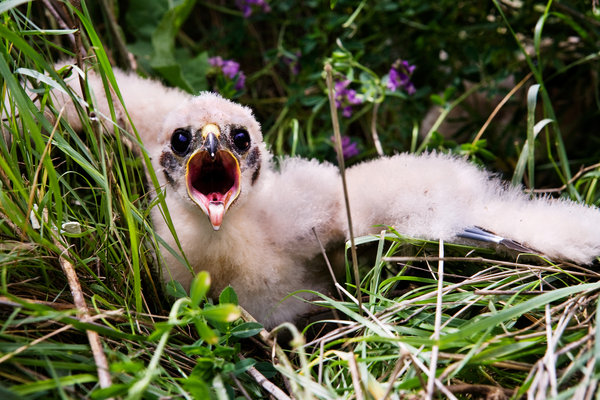 | Prairie Falcon |
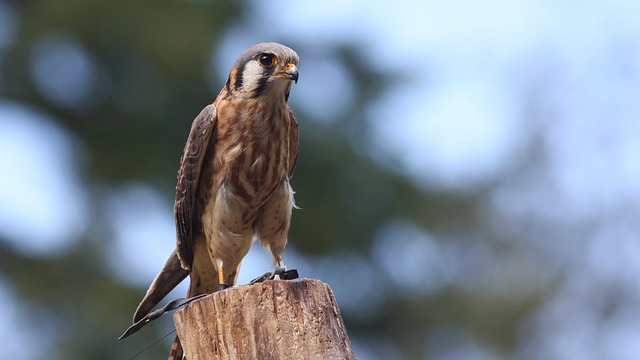 | American Kestrel |
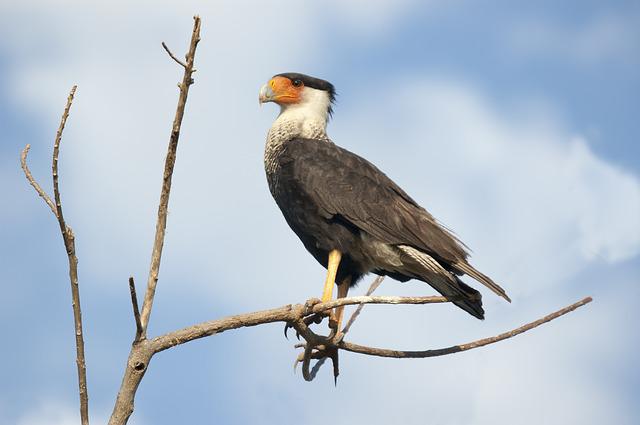 | Crested Caracara |
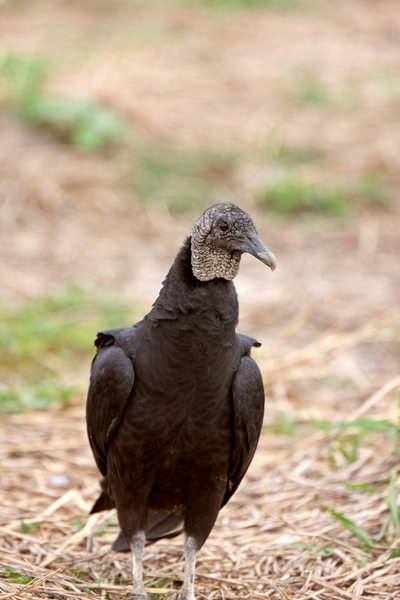 | Black Vulture |
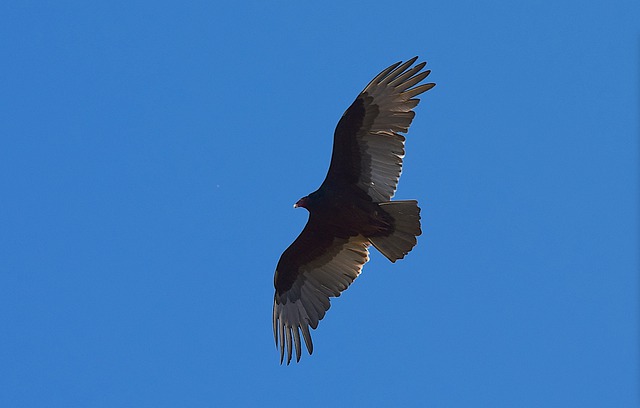 | Turkey Vulture |
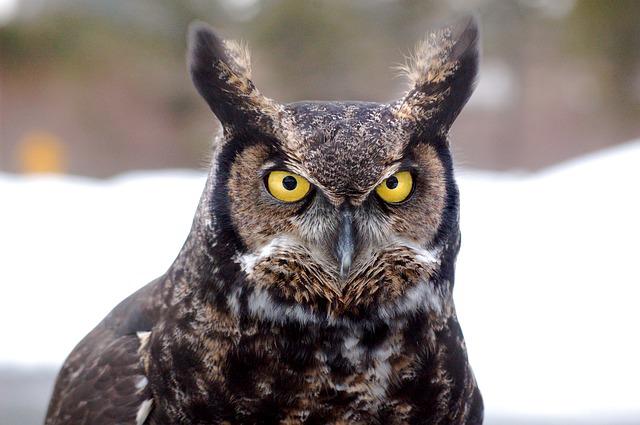 | Great Horned Owl |
 | Long-eared Owl |
 | Barn Owl |
 | Burrowing Owl |
 | Western Screech-Owls |
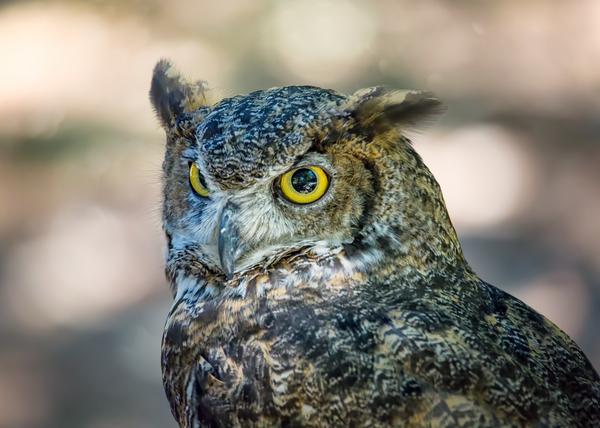 | Northern Pygmy Owl |
 | Short-eared Owl |
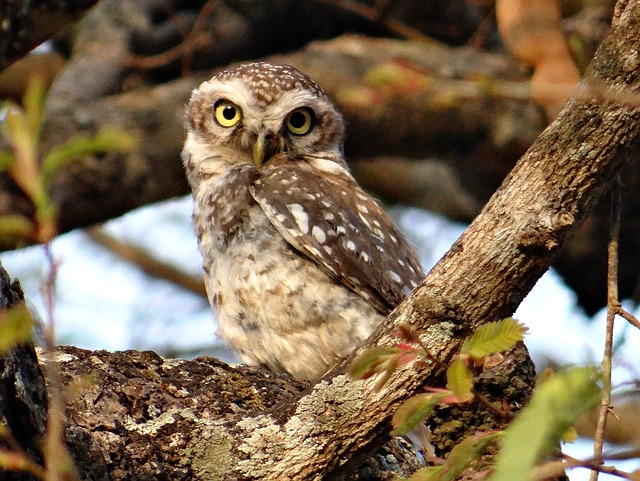 | Spotted Owl |
Birds of Prey in Arizona
1. Red-tailed Hawk

The Red-tailed hawk is among the larger types of hawks throughout Arizona, with a maximum wing span of 51 inches (4.5 feet).
Its coloration varies from dark brown to almost completely white, but its rusty red tail is always a giveaway.
In addition to its natural habitat of open grassland, this large hawk can also be found in human-dominated environments such as cities.
Its preferred hunting spot is a fence or post by the side of the road.
Among the most prevalent hawk species in Arizona, the Red-tailed Hawk is present all over the Grand Canyon State throughout the entire year.
This bird of prey swoops down from its perch to capture rodents as well as other small animals that have ventured out into the open.
2. Cooper’s Hawk

This small Arizona hawk is very quick and skilled when it relates to snatching flying birds.
It will even consume species that are much larger than itself on occasion.
Cooper’s Hawk males are grayish-blue on top and have distinctive reddish-orange bars on their undersides.
They have fiery red eyes that pierce you.
When you see a Cooper’s Hawk sitting on a limb, you may get a good look at its orange breast and bottom.
Cooper’s Hawks are able to make swift twists and rapid movements amid the dense foliage of woods and bushes because of their long tail and tiny, rounded wings.
Range
Although Cooper’s Hawks were formerly rare in urban settings, such as Tucson and Phoenix, they have since spread and are now often seen in the city, where they hunt songbirds and doves.
Cooper’s Hawks are known to make surprise visits to bird feeders in an attempt to attack unsuspecting songbirds by launching themselves at them from a high, concealed perch.
In the northern regions of North America, it only appears during the summer, but in Arizona, it is a year-round resident.
3. Sharp-Shinned Hawk

In contrast to the state’s largest hawk, the red-tailed hawk, the sharp-shinned hawk is the smallest and can be seen regularly in backyards across the state because it preys on songbirds.
These hawks are small, agile, and have a distinct pattern of orange feathers on their chests; their wings and backs are a blue-gray color.
Sharp-Shinned Hawks have a limited mating range in the northern and eastern parts of Arizona; however, they can be found all across the state at other times of the year.
Sharp-Shinned Hawks are among the most common type of Canadian birds to spend the winter in Arizona.
4. Northern Goshawk

Northern Goshawks are considerably larger than both Cooper’s and Sharp-shinned Hawks, making them Arizona’s largest accipiter hawk.
It resembles buteo hawks in size and shape, particularly the length of its wings and the shape of its tail.
Habitat
Buteo hawks spend a lot more time in the air and on perches in visible areas, whereas this species spends much less time doing either.
Rather, the Northern Goshawk hunts by flying low over open forests or along forest edges, surprising its prey in the open.
When hunting from a perch, this hawk is typically difficult to spot because of its camouflage.
During the breeding season, Northern Goshawks are only found in the eastern half of Arizona, but they are year-round residents everywhere else in the state.
5. Swainson’s Hawk

A little buteo, the Swainson’s Hawk, may be seen in Arizona’s summers soaring over dry plains and open places.
Long and slender, the wings of these hawks are distinguished by the stark contrast between the brown breast and the white undersides and chin.
Migratory birds of prey like Swainson’s Hawks spend the colder months of the year in Argentina.
Flocks reaching the hundreds of thousands go south in the autumn, sometimes accompanied by other species like Broad-winged Hawks.
From April through September, the Grand Canyon State is home to many flocks of these common hawks.
6. Harris Hawk

The buteo hawk is a large bird with a long tail and legs.
A dark brown raptor has chestnut spots on its shoulders and lower legs.
The white terminal line at the base of a Harriss Hawk’s tail is yet another fantastic identifying characteristic, especially while the bird is riding thermals.
Range
Although this species of hawk is more at home in South America and Mexico, it also breeds in southern Arizona.
Harris’s Hawks, unlike other hawk species, are very sociable and frequently hunt in groups of three or more.
Hawks that work together are more effective than solitary birds while hunting, according to researchers.
7. Rough-legged Hawk

Although it is a bird of the arctic tundra across northern Canada and Alaska, the Rough-legged Hawk spends the winter in many sections of the United States.
From October through March, you may get a glimpse of this species in Arizona, where it thrives in the state’s pastures, wide fields, and even marshes.
It usually hunts from a perch like a fence post or telephone pole, although it may hover like a kestrel if necessary.
Large buteo hawks may be recognized by their dark brown underbellies, which stand in stark contrast to the white tips of their wings and tails.
8. Northern Harrier

The Northern Harrier may nest in the Arctic, but it migrates south for the winter, spending its time in Central America and the southern United States.
From October through April, this harrier may be seen soaring over Arizona’s vast grasslands and wetlands.
One of the best ways to spot a harrier is by watching how it acts.
They hunt by flying gently a few feet above the ground and pouncing on any rodent that happens to be out of its hole.
9. Zone-tailed Hawk
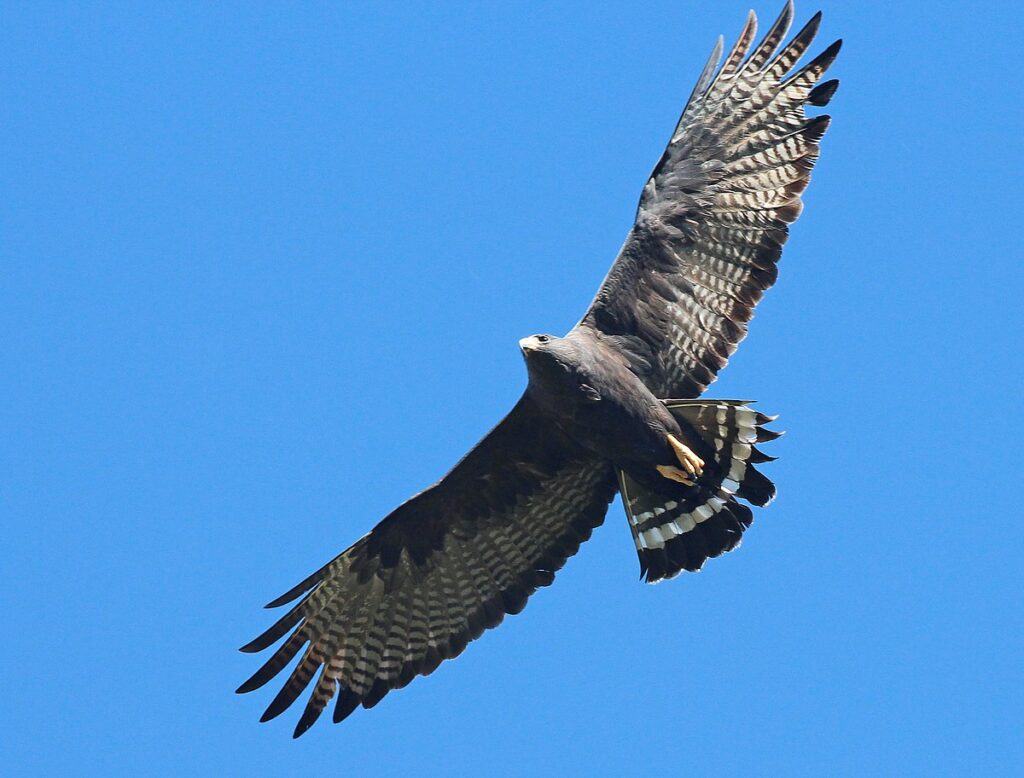
Another migratory hawk species, the Zone-tailed Hawk, may be seen in southern Arizona during the summer months while it is nesting.
With the exception of the luminous bars on their flight and tail plumes, these hawks are nearly black.
It’s interesting to note that they look and act similarly to Turkey Vultures.
Because most of its prey species see Turkey Vultures as harmless, ornithologists think that Zone-tailed Hawks take advantage of this resemblance.
Food
They like to hunt reptiles, small animals, and birds on canyons, desert cliffs, and foothills.
10. Common Black Hawk
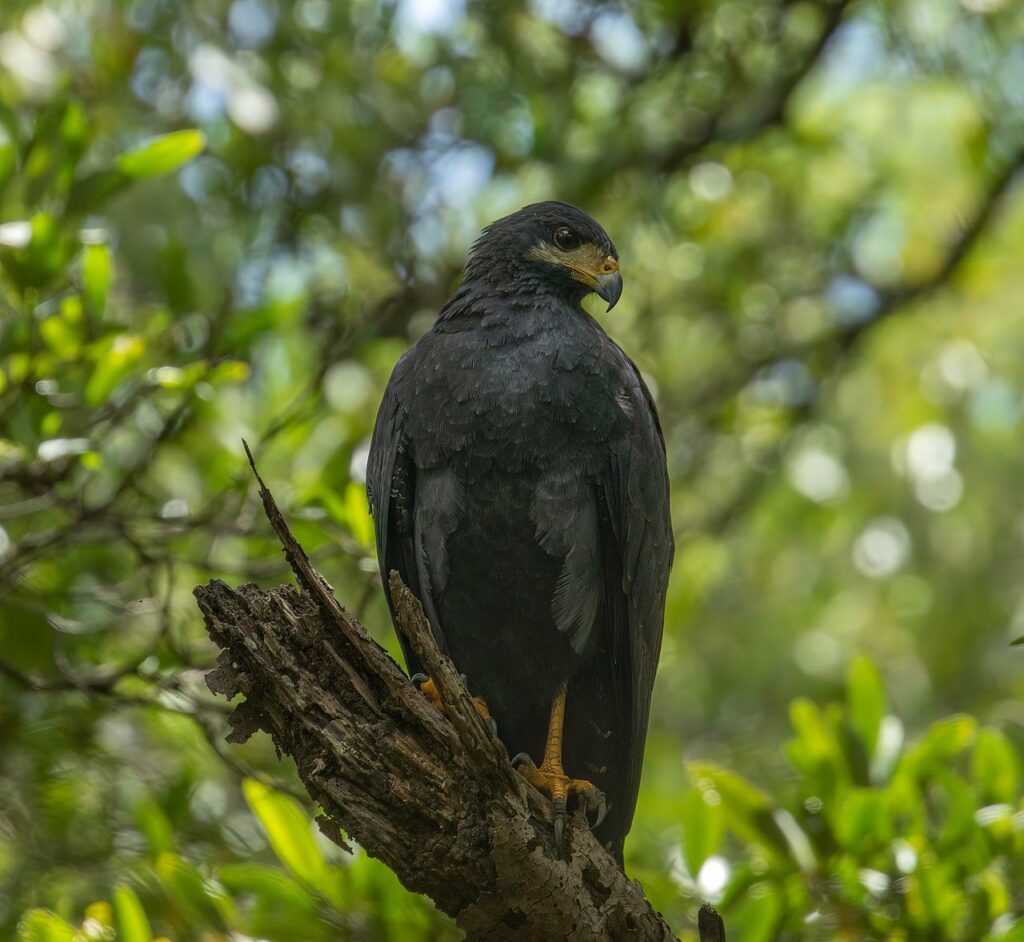
The wings of this huge hawk are quite wide, but its tail is comparatively small.
The base of its tail is white, while the rest of its body is a striking soot black.
Although prevalent in Central America and Mexico, Common Black Hawks may also be found in southern Arizona, where there is a breeding pair.
Food
Fish, amphibians, and rodents found in or near water are their primary prey, and they may be found in abundance in canyons with forested streams.
In September, these hawks begin their long journey south to spend the winter across Mexico.
Swamps and marshes are their preferred habitats in Central America.
11. Ferruginous Hawk

A very big buteo hawk, the Ferruginous Hawk, may be found in the western United States’ grasslands and deserts.
The biggest hawk throughout Arizona, its wingspan may reach up to 55 inches.
However, you can see this hawk anywhere in the state of Arizona outside of the mating season since it only breeds in the northern part of the state.
There are two different variants of this species, distinguished by their coloration; however, the lighter morph is much more frequent.
The underside of the light variant is pure white, while the head is gray and the rest of the body is a reddish brown.
Prairie dogs make up a significant portion of these hawks’ diet; however, they also eat other small animals.
12. Golden Eagle

The majestic Golden Eagle can be found in the western states of the United States, where it breeds.
The Arizona Golden Eagle is a resident breeder in several parts of the state and is easily spotted at any time of the year.
The absence of white on the head is a distinguishing feature of the Golden Eagle, which sets it apart from the Bald Eagle.
Among several other species of raptor that can be noticed in both the New World and the Old World, the Golden Eagle is considered to be circumpolar.
13. Bald Eagle

The Bald Eagle, a massive raptor with a wing span of up to 8 feet, is a common sight over the Great Canyon State.
In addition to its massive size, the Bald Eagle is among Arizona’s most distinctive birds because of the striking contrast between its white tail and head and its uniformly dark brown body.
A young Bald Eagle’s overall coloring is dark brown, with light, irregular streaking all over its body and a buffy white underbelly.
Range
This large raptor primarily breeds in central Arizona, but it can be seen throughout the state at other times of the year.
The bald eagle spends a lot of time flying high on thermal currents with its wings spread out flat. Birds, fish, and small mammals make up a portion of their diet, but carrion is also a staple.
14. Osprey

The Osprey isn’t an eagle, but it looks like one because of its large size and wingspan (up to 69 inches/5.5 feet).
The Osprey can be recognized by its blackish-gray upper parts, white underparts, and black wrist spots all over its lower wings.
Unlike any other raptor, this large Arizona bird will actually dive headfirst into the water in an effort to catch fish, sometimes going completely under the surface as it tries to grab a fish, including its feet.
As a result of their hunting methods, Ospreys are usually never seen far from water, with the exception of when they are migrating, when they will fly across land that lacks water.
In central Arizona, the Osprey is an uncommon breeder, but in southern Arizona, it is a common winter visitor.
15. Peregrine Falcon

The peregrine falcon holds the record for the fastest known animal.
This incredible falcon can dive from above at over 200 miles per hour!
Because of this, it is among the most successful Arizona raptors.
In contrast, Peregrine Falcons rely almost entirely on bird prey, while Prairie Falcons eat a variety of different animals.
As a result of their diet, peregrines were especially vulnerable to the effects of the pesticide DDT on eggshells, which led to a catastrophic declining population in the 1960s and 1970s.
The beautiful Peregrine Falcon was once very rare in Arizona, but since DDT was banned, its population has rebounded, and it is now a common sight across the state.
16. Prairie Falcon

Those who call Arizona’s wide-open expanses home may likely see Prairie falcons swooping down from the sky to pounce on unsuspecting ground-dwelling prey.
Flying low over the grassland and prairie, they ambush unsuspecting birds and mammals before pouncing on them.
Prairie Falcons are large birds that are found frequently in Arizona.
However, their brown coloring can make them difficult to spot in the wild, which actually works to the benefit of the species.
17. American Kestrel

In addition to being the smallest falcon in North America, the American Kestrel is also among the continent’s most frequent raptors.
Appearance
The male American Kestrel is a bright bird with a rufous orange head and tail, grayish-blue wings, and blackened tips.
The male additionally has a black mustache, a dark bar above one eye, and a reddish-orange cap on his head.
Female American Kestrels are often paler than males, although both sexes exhibit rufous orange on their backs and wings.
It’s like hunting from a high vantage point, such as a telephone pole or a tree limb, across open fields and meadows.
In order to catch a rat or other small mammal, the American Kestrel will descend to the ground and strike with its talons.
Insects and worms are among the most frequent prey during the summer and spring months, whereas rodents and small birds are the most frequent prey during the winter months.
It likes to set its home in old Woodpecker burrows or other unused crevices and cracks in structures.
They will even use human-made nesting boxes.
To the north, the American Kestrel is a migrating raptor, while in the south, it is a permanent resident.
It lives in Arizona all year round.
18. Crested Caracara

Caracaras are related to falcons, but their large bills, long legs, and habit of walking on the ground give them a very different appearance.
Throughout southern Arizona, close to the Mexican border, Crested Caracaras are a rare breed of bird, but their population is on the rise.
These raptors, like vultures, often dine on dead animals.
In the wild, you’ll most often see them perched in a lofty tree or gliding low to the ground.
19. Black Vulture

The only time you’ll see a Black Vulture in Arizona is if one happens to be a stray from Mexico or the Southeastern United States.
The only non-black parts of a Black Vulture are the white tips of the wings, which are only visible when looking up.
They have dark, wrinkled skin on their bare scalp.
Since adult couples tend to stick to their breeding territory throughout the year, the Black Vultures seen in Arizona are likely juveniles.
Black vultures, unlike their turkey vulture cousins, have a less developed sense of smell.
This is why Turkey Vultures are frequently employed as “scouts” to locate roadkill and scare away other, smaller vulture species.
20. Turkey Vulture

The Turkey Vulture, with a wing span of up to 6.1 feet, is the biggest of the vulture species that makes its home in Arizona.
Appearance
When in flight, you can notice that this large black raptor has a bright red head and dark gray tail feathers.
When in flight, a Turkey Vulture is easily recognized by the V shape of its wings and the brightness of its wingtips.
This large raptor prefers open areas with scattered woods and spends the summer months in Arizona, where it visits and breeds.
This raptor, like other vultures, has a strong preference for eating dead animals and can often be seen congregating in large groups near areas with fresh roadkill.
Black vultures share some physical characteristics with Turkey vultures but are much less common in the state of Arizona.
21. Great Horned Owl

The Great Horned Owl, with a wingspan of up to 4 feet, is the biggest owl species found in Michigan.
It has enormous, bright eyes and two tufts of brown feathers on its head that might be mistaken for horns.
This owl begins nesting in Arizona as early as January or February of each year.
Behavior
This animal is nearly exclusively nocturnal and relies on its acute sense of hearing to hunt at night.
In order to reproduce, the Great Horned Owl uses the nests of other big birds, including herons or raptors, rather than constructing its own.
It inhabits a broad range of environments in Michigan, from forests to city streets, and is spotted year-round in Arizona.
The duck-sized birds and the rabbit- and fox-sized offspring are no match for this owl’s hunting prowess.
22. Long-eared Owl

In comparison to the previously listed species, these sneaky owls are much smaller.
It is most at home in thick forests, where it may stalk the tiny rodents and animals that make the grasslands their home.
Like other owls, Long-eared Owls have fringes on their flying plumage that allow them to glide through the air undetected.
Together with their acute hearing, this helps them surprise their prey at night and capture it.
In spite of their stealthy nature, these widespread Arizona owls are easily recognized by their lengthy, low hoots.
In addition to the large tufts of plumage on their ears, these owls may be recognized by the droppings left behind in the grassy regions near the coniferous trees.
23. Barn Owl

The Barn Owl, with its white plumage and “friendlier” demeanor, is a less imposing species of owl than the Great Horned Owl.
Barn Owls are very elusive since they are nocturnal raptors with excellent night vision. Their distinctive shrieking sounds, however, make them easy to spot.
If you happen to see one flying in the sky during a full moon, you may even be able to make out its white underbelly.
These owls can be seen in Arizona throughout the year, and they prefer hunting in grassy fields and open woodland.
24. Burrowing Owl

The Burrowing Owl is a rare sight in Arizona’s open spaces. The burrows it uses are either dug by itself or occupied previously by prairie dogs or ground squirrels.
This owl is nocturnal but also forages during the day for insects and small rodents.
The vastness of the prairies makes it difficult to spot these owls, which are relatively small.
They prefer to perch on top of a small mound and look for food from above.
25. Western Screech-Owls

Despite being native to open forests, Western Screech-Owls have adapted well to urban environments and are now common sights in large gardens, parks, and even golf courses.
The best way to spot these birds, which breed in tree holes, is to listen for their distinctive series of rapidly increasing hoots.
These owls are regularly seen all year long in Arizona. Worms, rodents, and insects are just some of the many small animals that make up their varied diet.
Putting up nest boxes in your backyard is a great way to attract Western Screech-Owls, as these birds readily accept artificial nesting holes.
26. Northern Pygmy Owl

Arizona is home to the smallest owl in the world, the Northern Pygmy Owl.
Despite its diminutive size, this bird is a fierce predator that frequently brings in prey twice its size, including songbirds.
When it’s daytime, this owl is at its most effective for hunting.
It likes to sit in a secret spot and then bolt if a songbird comes too close.
There is a common belief that if songbirds see a Pygmy Owl, they will mob it until it gives up and goes flying.
Observing flocks of mobbing songbirds is a surefire way to locate Northern Pygmy Owls, which can otherwise be difficult to spot.
27. Short-eared Owl

Although the Short-eared Owl does not breed in Arizona, it is a common sight in the state during non-breeding months.
Unlike other owls, Short-eared Owls frequently hunt during the day.
This, in addition to the fact that they hunt by swooping low over the ground in open spaces, makes them easy to spot.
These owls are common in Arizona’s wide open spaces, such as farms, airports, and abandoned fields.
28. Spotted Owl

Since their preferred habitat, old-growth forest, has been declining throughout its range in North America, these owls are becoming rarer and rarer.
The Mexican Spotted Owl is among three distinct species of the Spotted Owl found in North America, and it can be found in Arizona.
This owl is hard to spot because its range is so fragmented across the Grand Canyon State.
The hooting calls of these owls are a reliable way to tell them apart from other owl species, just as they are for many other owls.
It consumes small mammals like other owls do, with a preference for flying squirrels and woodrats.
Conclusion
The most frequent raptors in Arizona are described above.
There are more than 500 kinds of birds that call Arizona’s dry landscape home, and many of them are raptors.
In their capacity as top predators, birds of prey like hawks, eagles, falcons, vultures, and owls are indispensable.
Raptors play a crucial role in regulating populations of rodents and other small mammals, and they also aid in the decomposition of animal carcasses through scavenging.
FAQ
What is Arizona's State Bird of Prey?
Falcon-like bird known as a Ferruginous Hawk. There are some stunning raptors that call the Western deserts and prairies home, and one of those is the Ferruginous Hawk. They have long, broad wings and a wide rusty, gray, or white tail, making them one of Arizona’s largest birds of prey.
Which hawk in Arizona is the largest?
The ferruginous hawk is the largest hawk throughout North America. On the other hand, their feet are noticeably smaller. Birds of prey, or raptors, are year-round residents in northern Arizona but are seasonal visitors in the south.
Last Updated on March 22, 2023 by Lily Aldrin
